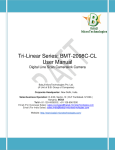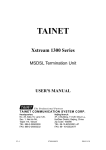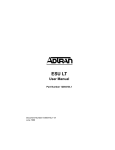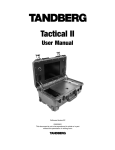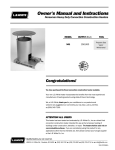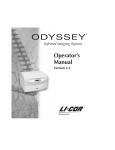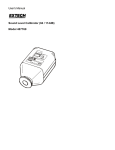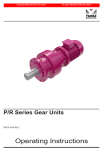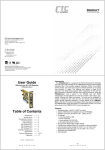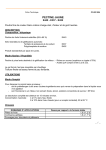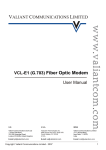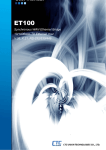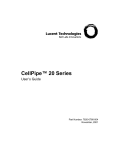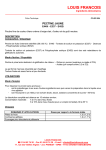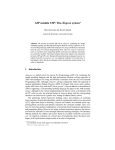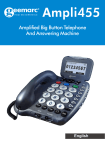Download MSDTU01A/E1 User`s Manual
Transcript
User's Manual Version 1.1 Contents Overview ..............................................................................................3 Features...............................................................................................4 Applications..........................................................................................4 Specifications.......................................................................................5 Packing.................................................................................................6 Appearance..........................................................................................7 Front Panel........................................................................................7 Rear Panel.........................................................................................8 Important Safety Instructions ..............................................................9 Installation .......................................................................................... 11 Hardware Setup................................................................................. 12 Point-to-point Operation .................................................................... 14 Console Operation............................................................................. 15 Console Operation / Configuration ................................................... 16 Cables ................................................................................................ 20 Version History V1.0 released May 7, 2001 V1.1 released September 24, 2001 firmware 1.14, supports connection to datacom unit 1 Version 1.1 2 Version 1.1 MSDTU01-A/E1 SDSL G.703 E1 CSU Overview The MSDTU01-A/E1 SDSL with G.703 Fractional E1 interface is a data access Channel Service Unit modem with the latest multi-rate HDSL (High-speed Digital Subscriber Line) technology offering both long range and high speed data transmission with Nx64 rates from 128Kbps up to 2048Kbps. The transmitting data rate may be adapted for the best "rate vs. range" performance for efficient and stable data transmission. The MSDTU01-A/E1 uses the 2B1Q line code with echo cancellation to transmit its high data rate over a single twisted pair of telephone wires without being affected by bridge taps or mixed cable links. It also provides high immunity to background noise and enables transmission over multiple pair cables. 3 Version 1.1 MSDTU01-A/E1 SDSL G.703 E1 CSU Features 4 4 4 4 4 4 4 4 4 4 4 High speed SDSL transport over single twisted Copper pair telephone lines 2B1Q line code Symmetrical Multi-rate Nx64 data transmission from 128Kbps to 2048Kbps G.703 E1 operates from recovery (E1 at CO), or loop recovery (E1 at RT) timing modes Simple operation Low power consumption Transparent data over SDSL Point-to-point data transmission service Configure and Loop Test via RS-232 Craft port Local and remote loopback features Integral BERT generator Applications Application : Point-to-Point Connection for Network Extension Application : Point-to-Point Connection with V.35 Data Com Unit (Must be at least version 1.4 firmware.) 4 Version 1.1 MSDTU01-A/E1 SDSL G.703 E1 CSU Specifications Item Channel Port MSDTU01-A/E1 Interface ITU-T G.703 E1 Connector Impedance BNC(x2) unbalanced, RJ-45 Balanced 75 or 120 Ohms, selectable 75 Ohm: Pulse 2.37V nominal 120 Ohm: Pulse 3.00V nominal 0 to –43dB 2.048Mbps HDB3 Unframed, CAS, CCS, CRC4 On/Off Recovery at CO, DSL Loop Recovery Meets ITU-T G.823 ITU-T G.703, G.704, G.706, G.732 Tx Level Relative Rx Level Bit Rate Line Code Framing Timing Source Jitter Tolerance Complies with WAN Port -SDSL Line I/F Indicators LED Transmission Rate : 144 Kbps – 2320 Kbps Data Rate : Line Code Line Impedance Test Standard Connection Loops Connector Power (WAN) LOS LFA ALARM LOOP (E1) SigLoss SyncLoss ALARM LOOP 144 Kbps – 2320 Kbps 2B1Q 135 Ω ANSI T1E1.413/94-006; ETSI ETR 152 One Pair (2-wire) RJ-11 Green LED, indicate power and operation Red LED, DSL Loss of Signal Red LED, DSL Loss of Frame Alignment Red LED, DSL Test & Error status Red LED, DSL in Loopback mode Red LED, E1 Signal Loss Red LED, E1 Sync Loss Red LED, E1 Alarm Red LED, E1 in Loopback mode OAM&P Local ASCII Terminal via EIA RS-232 Port Environment Temperature Humidity 0°C ~ 50°C 5% ~ 95% Dimensions (WxDxH) CO/RT 213(w)mm X 152(d)mm X 25(h)mm Electrical Power Input 12VDC via AC Adapter Power Consumption Less than 8 Watts 5 Version 1.1 MSDTU01-A/E1 SDSL G.703 E1 CSU Packing This package shall contain the following items: 1. MSDTU01-A/E1 unit 2. AC Adapter (120VAC for North America, and 220-240VAC for Europe) 3. RS-232 Serial Cable, DB-9 to DB-9(optional) 4. This User's Guide 6 Version 1.1 MSDTU01-A/E1 SDSL G.703 E1 CSU Appearance Front Panel After connecting all cables and powering on the MSDTU01A/E1, LED’s on the front panel shall indicate the following status. LOOP – Test/Loopback ALARM – E1 Alarm SyncLoss – E1 Sync Loss SigLoss – E1 Signal Loss LOOP – DSL Test/Loopback ALARM – DSL Alarm/Error LFA – DSL Loss of Frame Alignment LOS – DSL Loss of Signal POWER – Unit Power Applied The LED indicators provide an excellent indication of the communication status and possible link trouble locations when troubleshooting "link-down" problems. 7 Version 1.1 MSDTU01-A/E1 SDSL G.703 E1 CSU Rear Panel RJ11, SDSL for connection to local loop DB9, console port for connection to ASCII data termina l RJ-45, Balanced G.703 E1 Port, BNC, Unbalanced G.703 E1 Port 10P DIP switch, for setting speed, CO/CPE, Timing, E1 Framing, Nx64, etc. Power Jack, for connecting to a AC-DC power adapter, 12VDC, 1A 8 Version 1.1 MSDTU01-A/E1 SDSL G.703 E1 CSU Important Safety Instructions The following safety instructions apply to the MSDTU01-A/E1: 1. Be sure to read and follow all warning notices and instructions. 2. The maximum recommended ambient temperature for MSDTU01-A/E1 is 40? (104? ) Care must be taken to allow sufficient air circulation or space between units when the MSDTU01-A/E1 is installed inside a closed rack assembly. The operating ambient temperature of the rack environment might be greater than room temperature. 3. Installation in a rack without sufficient air flow can be unsafe. 4. Racks should safely support the combined weight of all equipment. 5. The connections and equipment that supply power to the MSDTU01A/E1 should be capable of operating safely with the maximum power requirements of the MSDTU01-A/E1. In the event of a power overload, the supply circuits and supply wiring should not become hazardous. The input rating of the MSDTU01-A/E1 is printed on the nameplate. 6. The AC adapter must plug in to the right supply voltage, i.e. 120VAC adapter for North America and 230VAC adapter for Europe. Be sure the supplied AC voltage is correct and stable. If the input AC voltage is more than 10% lower than the standard may cause malfunction of the MSDTU01-A/E1 unit. 7. Installation in restricted access areas must comply with Articles 110-16, 110-17, and 110-18 of the national Electrical Code, ANSI/NFPA 70. 8. Do not allow anything to rest on the power cord of the AC adapter, and do not locate the product where anyone will walk on the power cord. 9. Do not service the product by yourself. Opening or removing covers can expose you to dangerous high voltage points or other risks. Refer all servicing to qualified service personnel. 10. Generally, when installed in the final configuration, the product must comply with the applicable safety standards and regulatory requirements of the country in which it is installed. If necessary, consult the appropriate regulatory agencies and inspection authorities to ensure compliance. 9 Version 1.1 MSDTU01-A/E1 SDSL G.703 E1 CSU 11. A rare condition can create a voltage potential between the earth grounds of two or more buildings. If products installed in separate building are interconnected, the voltage potential can cause a hazardous condition. Consult a qualified electrical consultant to determine whether or not this phenomenon exists and, if necessary, implement corrective action before interconnecting the products. If the equipment is to be used with telecommunications circuit, take the following precautions: 4 Never install telephone wiring during a lightning storm. 4 Never install telephone jacks in wet location unless the jack is specially designed for wet location. 4 Never touch uninsulated telephone wires or terminals unless the telephone line has been disconnected at the network interface. 4 Use caution when installing or modifying telephone lines (other than a cordless telephone) during an electrical storm. There is a remote risk of electric shock from lightning. 4 Do not use a telephone or other equipment connected to telephone lines to report a gas leak in the vicinity of the leak. 10 Version 1.1 MSDTU01-A/E1 SDSL G.703 E1 CSU Installation 1. Connect the local loop (twisted copper pair telephone wire) to the WAN port at the RJ-11 jack. Be sure that this local loop has been properly connected to another MSDTU01-A/E1 remote unit. 2. Connect the E1 transmission line to the modem at the BNC connectors marked "TX" and "RX". Alternately, connect the twisted pair E1 cable to the RJ-45 connector. Please refer to the section on "Cables" for detailed pin assignment. 3. • Power connection -- • • 4. • Warning : Do not apply the AC power before all the connections above have been connected. Connect the DC jack to the DC-IN of the unit Plug in the AC Adapter to the wall AC socket Terminal Connection -A data terminal or PC with emulation software can be connected to the TERMINAL port (RS-232) of the unit for configuration & monitoring purpose. Use an RS-232 serial cable to connect to a ASCII data terminal. The TERMINAL should be VT-100 compatible. 11 Version 1.1 MSDTU01-A/E1 SDSL G.703 E1 CSU Hardware Setup DSL rate and terminal type can be set up by adjusting the 10-pole DIP switch on the rear panel. Sw. 1 is for SDSL termination type, Sw.2 thru Sw. 6 are for adjusting the E1 and DSL rate, Sw. 7 will disable TS0, Sw. 8 and Sw. 9 set E1 frame mode, and Sw. 10 sets the E1 line termination. ON 1 1. Rate Setting Table E1 Rate (TS0+data) 128K ON OFF OFF OFF OFF TS used for data 1 192K OFF ON OFF OFF OFF 2 208K 144K 256K ON ON OFF OFF OFF 3 272K 208K 320K OFF OFF ON OFF OFF 4 336K 272K 384K ON OFF ON OFF OFF 5 400K 336K 448K OFF ON ON OFF OFF 6 464K 400K 512K ON ON ON OFF OFF 7 528K 464K 576K OFF OFF OFF ON OFF 8 592K 528K 640K ON OFF OFF ON OFF 9 656K 592K 704K OFF ON OFF ON OFF 10 720K 656K 768K ON ON OFF ON OFF 11 784K 720K 832K OFF OFF ON ON OFF 12 848K 784K 896K ON OFF ON ON OFF 13 912K 848K 960K OFF ON ON ON OFF 14 976K 912K 1024K ON ON ON ON OFF 15 1040K 976K 1088K OFF OFF OFF OFF ON 16 1104K 1040K 1152K ON OFF OFF OFF ON 17 1168K 1104K 1216K OFF ON OFF OFF ON 18 1232K 1168K 1280K ON ON OFF OFF ON 19 1296K 1232K 1344K OFF OFF ON OFF ON 20 1360K 1296K 1408K ON OFF ON OFF ON 21 1424K 1360K 1472K OFF ON ON OFF ON 22 1488K 1424K No.2 No.3 No.4 No.5 No.6 DSL Rate 144K TS0 Dis. DSL Rate 114K 1536K ON ON ON OFF ON 23 1552K 1488K 1600K OFF OFF OFF ON ON 24 1616K 1552K 1664K ON OFF OFF ON ON 25 1680K 1616K 1728K OFF ON OFF ON ON 26 1744K 1680K 1792K ON ON OFF ON ON 27 1808K 1744K 1856K OFF OFF ON ON ON 28 1872K 1808K 1920K ON OFF ON ON ON 29 1936K 1872K 1984K OFF ON ON ON ON 30 2000K 1936K 2048K ON ON ON ON ON 31 2064K 2000K Unframed OFF OFF OFF OFF OFF 32 2064K 2064K 12 Version 1.1 MSDTU01-A/E1 SDSL G.703 E1 CSU The E1 data rate is equal to the number of timeslots used for data times 64 Kbps, plus 64 Kbps for timeslot zero (framing timeslot). The DSL data rate is equal to the E1 data rate plus 16 Kbps overhead. The TS0 Dis. (Timeslot zero disabled) DSL rate is equal to the number of timeslots used for data plus 16 Kbps overhead. Use this rate setting to match a remote datacom unit's HDSL rate ( CCS framing ONLY). 2. 3. CO/RT configuration Terminal type DIP SW No. 1 CO ON RT OFF Framing, CRC4 and termination configuration Sw. 7* Sw. 8 Sw. 9 Sw. 10 TS0 Frame Mode CRC4 E1 Term. ON Disable CAS** CRC4 On 75 Ohms OFF Enable CCS*** no CRC4 120 Ohms * Normal operation with two MSDTU01A/E1 units enable timeslot zero (TS0). (Please refer to the first application on page 4). If the MSDTU01A/E1 unit is connected over DSL to an MSDTU01A (refer to the second application on page 4) datacom unit (V.35, X.21, RS-530 or RS-449), then follow these rules. 1. Unframed E1: Enable TS0 and set E1 rate to "Unframed", set remote datacom unit's HDSL rate to 2064Kbps (data rate + 16Kbps). 2. CCS framing: Disable TS0 and match the "TS0 Dis" rate to the remote datacom unit's "HDSL rate" (data rate + 16Kbps). When timeslot zero is disabled, the unit allows E1 data to transmit transparently to the datacom side. The E1 side will not send TS0 to the far Datacom. Likewise, the E1 unit will regenerate TS0 from the Datacom side to send to the connected E1 equipment. 3. CAS framing: Not support when connected to remote datacom unit. **CAS mode may also be referred to as PCM30. In this mode, both timeslots 0 and 16 are used for frame alignment and signaling. Other timeslots are available to carry data. ***CCS mode may also be referred to as PCM31. In this mode, timeslot 0 is used for frame alignment and all other timeslots are available to carry data. 13 Version 1.1 MSDTU01-A/E1 SDSL G.703 E1 CSU Point-to-point Operation 1. The MSDTU01-A/E1 should be located on each side of the connection. One side must be set to "CO" and the other side must be set to "RT". Refer to the section on "Hardware Setup" for the CO & RT setup. Place the CO side unit towards the E1 timing source. 2. Insure that both CO & RT MSDTU01-A/E1s are set to the same DSL rate. For example, 784Kbps. 3. Make sure that both CO & RT MSDTU01-A/E1s have been connected to the E1 line properly. 4. For normal operation, 75 Ohm termination should be selected (DIP sw no. 10) when connecting the E1 over unbalanced coaxial cable at the BNC connectors, while 120 Ohm termination should be selected when connecting the E1 over balanced twisted pair cabling at the RJ-45 connector. DO NOT connect E1 signals to both the BNC and RJ-45 connectors at the same time. 5. When placing the MSDTU01-A into an E1 network, the source of timing is very important. Place the MSDTU01-A unit, which is closest to the E1 timing source, in CO mode and set E1 timing to "recovery". The E1 timing will be passed to the RT unit. The E1 device connected to the RT unit will be able to recover E1 timing from the RT unit. 6. Check the WAN LED on the MSDTU01-A/E1 -- it will remain lit when the Link is successfully established. The DSL training process may take around one minute and the WAN LED will flash during the training process. 7. After the DSL link is established, check the E1 setup. Both CO & RT side E1 must be set to use the same Frame Type. Both side E1 must also set the same E1/DSL rate parameter. Otherwise, they may fail to communicate with each other even though the DSL link is ready. 8. Follow the DSU/CSU manual to set the Frame type, clock source and other parameters. When the E1 parameters are properly set, you are ready to use the high-speed connection between the two networks. You may test the data transportation speed by using the internal BERT generator and loopback commands. 14 Version 1.1 MSDTU01-A/E1 SDSL G.703 E1 CSU Console Operation Starting Hyper-Terminal (on Windows 95 or Windows NT) To Start the Hyper-terminal, following the steps below: 1. Start "Hyper-terminal" program -− On Windows 95 or Windows NT : start Tool Bar à Program à Accessory à Hyper Terminal Group à Double Click Hypertrm.exe à Enter Connection Name à Select Icon à Click OK 2. Select COM port to communicate with the MSDTU01-A/E1-− Choose direct to COM1 or COM2 à click OK 3. Set up Port Properties -n Port Setting : − Bit per second : 9600 − Data bits : 8 − Stop bits : 1 − Parity bit: None − Flow Control : None n Settings : − Function, arrow, and ctrl keys act as : Windows keys − Emulation : Auto-detect − Back-scroll buffer lines : 500 n ASCII Setup: − Echo typed characters locally − Line delay : 0 milliseconds − Character line feeds t incoming line ends : enable 15 Version 1.1 MSDTU01-A/E1 SDSL G.703 E1 CSU Console Operation / Configuration 1.1 Turn on the power of MSDTU01-A/E1 and press any key, the initial terminal screen will be displayed. From any other menu, pressing ESC and Enter will return to the top menu screen. Pressing "zero" will exit any menu to the next higher level. : 1. 2. 3. 4. [MSDTU-01A] xDSL status BERT Loopback Test Information Select Number : 2.1 Information display— Press "4" to display information << Information >> Firmware Version : 1.14 Hardware Version : 1.1 FPGA Version : 1 CTC UNION TECHNOLOGIES CO., LTD. http://www.ctcu.com/ The firmware version, hardware version and FPGA version will be displayed. This information should be readily available to give to technical support in the event there are difficulties in configuring or applying the units. 3.1 xDSL status display -<< Status >> Terminal Type : HTU-C Symbol Rate : 336Kbps In Sig Level : 015dB Far-End Signal Atten. : 002dB Noise Margin :-15.5dB Tx Gain : -0.48dB Descriptions of xDSL status items -3.1. Terminal Type : Indicates whether the Terminal Type of this unit is set for Central Office (HTU-C) or Remote Terminal (HTU-R). In pointto-point operation, one unit must be set to CO while the other must be set to RT. 16 Version 1.1 MSDTU01-A/E1 SDSL G.703 E1 CSU 3.2. Symbol Rate : Indicates the DSL rate in kilobits per second. This is normally the data rate plus 16Kbps overhead. 3.3. In Sig Level : Indicates the input signal level of the DSL signal. 3.4. Far-End Signal Atten. : An approximate calculation of overall cable signal attenuation in dB. 3.5. Noise Margin : Shows Noise Margin value. The noise margin is defined as the maximum tolerable increase in external noise that still allows for a BER (bit error rate) of less than 10-7. 3.6. Tx Gain : Shows current transmission gain level in decibels. Nominal transmit power is 13.5dBm, while Tx gain may vary from –1.6dB to +1.4dB. 4.1 Select "3" Loopback Test << Loopback >> *1. OFF 2. PCM-PCM 3. Analog 4. Isolated 5. HDSL-PCM 6. Remote Line Select Number : _ 4.1. Item "1" OFF, will turn off any loopback mode. 4.2. Item "2" PCM-PCM, turns on PCM-PCM loopback mode. In this mode, the E1 signal coming in the Rx terminal is looped to the E1 Tx terminal. 4.3. Item "3" Analog, turns on analog loopback mode. In this mode the local DSL Tx is looped back to local Rx. The DSL cable MUST be disconnected. 4.4. Item "4" Isolated, turns on isolated analog loopback. This loopback is the same as item "3", except the DSL cable need not be disconnected. 4.5. Item "5" HDSL-PCM, turns on digital loopback. In this mode the remote received DSL signal is looped back to the remote unit. 17 Version 1.1 MSDTU01-A/E1 SDSL G.703 E1 CSU 4.6. Item "6" Remote Line, turns on remote digital loopback. This mode is used to test the DSL link.The local unit sends a command to the remote unit which then initiates its own HDSL-PCM loopback. This mode requires that an active DSL link already be established. PCM-PCM E1 Analog DSL Isolated E1 X E1 DSL HDSL-PCM DSL E1 DSL Remote Line E1 E1 DSL Figure examples of Loop back modes 18 Version 1.1 MSDTU01-A/E1 SDSL G.703 E1 CSU 5.1 Select "2" BERT 1. 2. 3. 4. << BERT >> Function Pattern Scale BERT Status Select Number : 5.1. BERT – Function : Selects the mode of Loop Back testing. *1. 2. 3. 4. << BERT Function >> OFF Normal PCM Framed PCM Serial Select Number : Normal mode selects the selected HDSL payload on a per-timeslot-basis. PCM Framed BERT tests only the selected PCM timeslots, while PCM Serial tests the entire PCM channel. 5.2. BERT – Pattern : There are four patterns available for BER Testing; 2e4-1, 2e15-1, QRSS, and 2e23-1 *1. 2. 3. 4. << BERT Pattern >> 2e4-1 2e15-1 QRSS 2e23-1 Select Number : 5.3. BERT – Scale : Test duration in bits transmitted. *1. 2. 3. 4. << BERT Scale >> 2^21 2^25 2^28 2^31 Select Number : 19 Version 1.1 MSDTU01-A/E1 SDSL G.703 E1 CSU 5.4. BERT – Status : << BERT Status >> Pattern SYNC : SYNC Measurement : Complete Bit Errors : 000 Press '1' to review. This display is used to review the results of testing. If there is no pattern sync the display will read "No SYNC". During the testing process the display will read "In Progress". The accummulated or final number of errors will be displayed. The register for counting errors is only 8 bits (256) and will increment back to zero when full. Cables / Connectors 1. 4 RS-232 Cable for connection to VT-100 type ASCII terminal TERMINAL (CRAFT) Port DB-9 DCE connector pin assignment, signal direction, and alarm relay contacts: MSDTU01-A 4 − − − − − − Pin 2 ------ RXD è DTE Pin 3 ------ TXD ç Pin 5 ------ SGND Pin 6 ------ Alarm relay common Pin 4 ------ Alarm relay NC (open on alarm) Pin 9 ------ Alarm relay NO (closed on alarm) Parameter : − − − − Data Speed : 9600 bps Parity : None Stop Bit : 1 bit Character Length : 8 Bits Modem cable Terminal cable 1 2 3 5 4 1 2 3 5 4 6 7 6 7 6 7 6 7 8 8 8 8 1 2 3 5 4 male male male 20 1 2 3 5 4 female Version 1.1 MSDTU01-A/E1 SDSL G.703 E1 CSU E1 BNC Connectors BNC TX RX Pin Center Sleeve Center Sleeve Designation TTIP TRING RTIP RRING Direction From MSDTU01-A ↔ To MSDTU01-A ↔ Function Transmit data Signal return Receive data Signal return Direction ↔ ↔ From MSDTU01-A From MSDTU01-A To MSDTU01-A To MSDTU01-A Function Frame Ground Frame Ground Transmit data + Transmit data Receive data + Receive data - Direction ↔ ↔ Function Transmit data Signal return E1 RJ-45 Connector RJ-45 GND TX RX Pin 8 7 4 5 1 2 Designation GND GND TTIP TRING RTIP RRING WAN DSL Connector Conn. TX/RX Pin 3 4 Designation TIP RING DC - IN Connector TIP ---- DC12V+ RING – Return (-) _ + 21 Version 1.1 MSDTU01-A/E1 SDSL G.703 E1 CSU 22 Version 1.1 CTC Union Technologies Co., Ltd. Far Eastern Edison Science and Technologies Center (Nei-Hu HI-TEC Park) 6F-3, Lane 360, Nei-Hu Road, Section 1 Nei-Hu, Taipei, Taiwan Phone:(886) 2.2659.1021 (Rep) Fax:(886) 2.2799.1355 E-mail: [email protected] http://www.ctcu.com


























